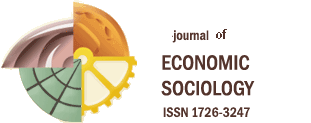2001. Vol. 2. No. 5 |
|
|
|
Editor’s Foreword
P. 3–5 |
Interviews
New Texts
|
Vladimir Gimpelson,
D Treisman,
Galina Monusova
Public Employment and Redistributive Politics: Evidence from Russia's Regions
P. 21–48 |
|
Public employment grew surprisingly fast in Russia during the 1990s, at a time when total employment was falling. Most of this growth occurred in the country's 89 regions, and rates varied among them. This paper seeks to explain this variation. Using panel data for 78 regions over 1992-1998 we test several hypotheses. We show that the increase in the share of public employment in total employment has been greatest where unemployment was highest and growing the fastest, in ethnically defined territorial units, and in regions which received larger federal transfers and loans. Regional governors appear to use public employment for several purposes: as a kind of economic insurance to cushion the population against unemployment; as a way of buying votes before elections; and, possibly, as a way of redistributing to minority ethnic groups. Their willingness to use it for any of these is conditioned by the level of federal financial aid they can attract. The paradoxical growth of public employment in Russia appears less a result of ignorant or irresolute central management than a perverse outgrowth of the competitive game of federal politics, in which regional governors use public sector workers as "hostages" to extract transfers. |
New Translations
|
Nicole Biggart
Social Organization and Economic Development
P. 49–58 |
|
In this paper I try to disprove the neoclassical assumption that all the markets should be similar to each other and their distinctions testify to their imperfection. Instead of speaking about the market model, taken in the economic theory I suggest the alternative view on the markets and market operation based on the four main assumptions. I claim that this point of view has been proved by the results of observations, and the social policy based on it turned out to be more reliable. |
Insight from the Regions
|
Svetlana Yaroshenko
The Poor of the North Rural Area of Transforming Russia: Double Exclusion
P. 59–78 |
|
The paper provides the analysis of the mechanism of stagnant poverty formation. The analysis is done on the basis of the longitudinal survey of the official poor and the territorial study of the north rural area. Rural poor are considered as one of the most deprived and socially-excluded groups, which are characterized by economic, social and spatial isolation from the main sources of life support in capitalistic Russia. This isolation is an important factor of the transformation from statistical group of poor to the real one. The main distinction of this group is not the lack of means to live but the stability of this position, recognition of inability to overcomeindigenceand special adaptation to support the family under the conditions of the exclusion from the labour market and inclusion into the system of social protection. However social help aimed at only the support of the achieved living standards could not be the channel for upward mobility for its receivers. |
Debut Studies
|
Anna Trusova
The Dynamics of the Middle Class in Russia in 1990s
P. 79–111 |
|
The paper is based on the assumption that Russian society has at least two middle classes at the same time. Using three criteria of the middle class identification (material position, professional qualification factor and self positioning) the author identifies the “core” (social group, having the basic indications of the middle class) and “proto-middle classes” (those who have one or several main indications) and analyzes their mobility then. The part of paper is devoted to the empirical study of the dynamics of the middle class and the analysis of the mobility of the chosen criteria. The study is based of the RLMS for 1995-1998. It was shown that the number of the main body of the middle class changed during the considered period not more than 10%, while its structure changed for 62% on average during the year. The same situation was disclosed for the proto-middle classes. As the result the author refuted the hypothesis of the stable core of the middle class |
Professional Reviews
|
Ton Korver
A Dutch Approach: a Little Bit of Everything or Economic Sociology in the Netherlands
P. 112–121 |
|
Lena Novikova
The Review of Internet Resources on Economic Sociology (part 4)
P. 122–126 |
New Books
|
Vladimir Yadov
Losses and Benefits in Russia of 1990s
P. 127–132 |
|
The Society of Unequal People
P. 133–135 |
Research Projects
|
Started Small Enterprises after the crisis of 1998
P. 136–137 |
|
Professional Education and Retraining under the Conditions of the Structural Transformation of Russian Economy
P. 138–140 |
Syllabi
|
Yana Roshchina
Sociology of consumption
P. 141–156 |
Conferences
|
Olga Kuzina
The 5th ESA annual conference “Visions and Divisions”
P. 157–160 |
|
Vadim Radaev
The 5th annual ISNIE conference
P. 161–167 |




.gif)






 ©
© 